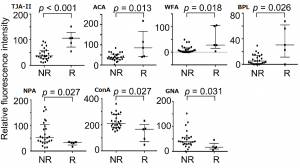A group from Juntendo University School of Medicine, etc. has found a unique glycosylation pattern in relapse-prone breast cancer comparing with non-relapsed cancer with using lectin microarrays.
https://journals.plos.org/plosone/article?id=10.1371/journal.pone.0250747
Breast cancer is one of the most common malignant tumors among women. Triple-negative breast cancer (TNBC) is a relapse-prone breast cancer subset that accounts for about 15–20% of all breast cancers and is defined by tumors lacking estrogen receptor expression, progesterone receptor expression, and increased expression of human epidermal growth factor receptor-2 (HER2). An adjuvant therapy, cytotoxic chemotherapy is the only available treatment option for TNBC patients, because they do not respond to hormone or anti-HER2 treatment.
Authors found that TJA-II, which has binding specificity to Fucα1-2Gal and/or β-GalNAc glycans, shows higher intensity in cell extracts from surgical specimens of relapsed TNBC patients than in non-relapsed patients, and histochemical TJA-II staining of adjacent sections confirmed this difference. Since two more lectins, WFA and BLP, showed similar tendency to TJA-II, some glycoproteins having β-linked terminal GalNAc are to be in the background of this finding. The next stage is definitely to find out new target molecules for the effective therapy of the relapse-prone TNBC subset.

